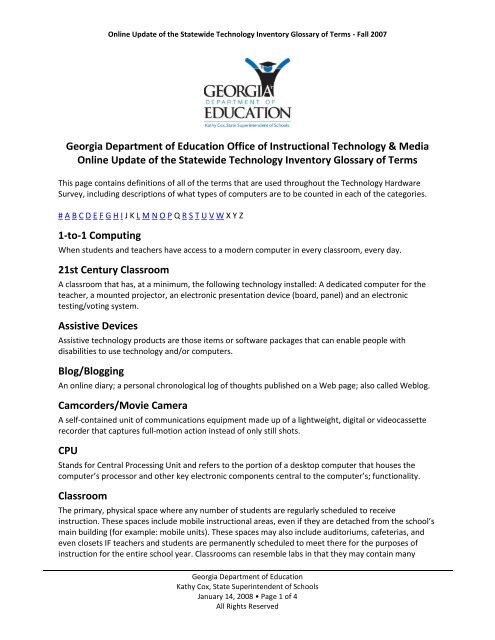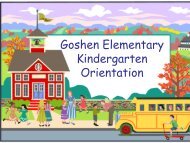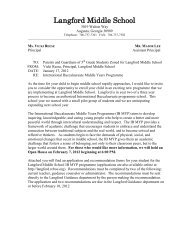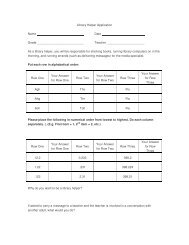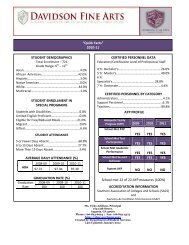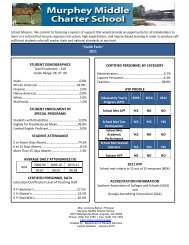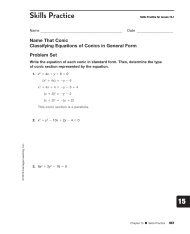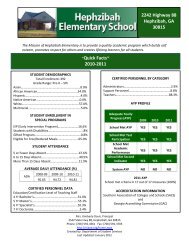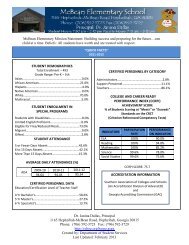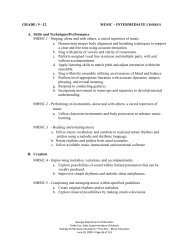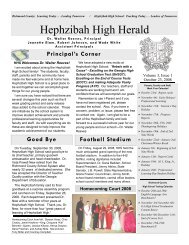State Glossary for Technology Terms
State Glossary for Technology Terms
State Glossary for Technology Terms
Create successful ePaper yourself
Turn your PDF publications into a flip-book with our unique Google optimized e-Paper software.
Online Update of the <strong>State</strong>wide <strong>Technology</strong> Inventory <strong>Glossary</strong> of <strong>Terms</strong> - Fall 2007computers. However, the difference between a classroom and lab is the way students are scheduled inthe space, not the number of computers. A classroom is the primary, regularly-scheduled meeting space<strong>for</strong> teachers and students. A lab is a place that students and teachers leave their regularly-scheduledmeeting place to visit. A room that does not have teachers/students regularly-scheduled during thisschool year is not to be counted as a classroom <strong>for</strong> this survey.Data/Video ProjectorA specialized projector with its own, internal lighting source that hooks to a computer monitor oranother visual display device and projects the image displayed by that monitor or display advice on amovie screen. Such devices are commonly used in presentations. Data/Video projectors can use eitherDigital Light Processing (DLP) technology, developed by Texas Instruments or light-crystal-displaytechnology (LCD). LCD projectors are distinguished from LCD panels in that they have their own lightsource; whereas, LCD panels borrow an overhead projector’s light source. LCD projectors should becounted in this category. LCD panels should not.DesktopsA computer designed to fit on top of a desk, typically with a separate CPU, monitor, and keyboard(although some computers, especially Macs, are all-in-one models). Desktop computers typically weigh30-50 pounds and are not considered portable like a laptop computer.Digital CamerasA camera that captures and stores still images as digital data instead of on photographic film.Direct-Connect PrintersA printer that is connected directly into the machine that will be printing to it. A non-networked printer.HardwareHardware is the physical aspect of computers, telecommunications, and other in<strong>for</strong>mation technologydevices. Refers to objects that can be touched, like disks, disk drives, display screens, keyboards,printers, boards, and chips.High-speed Internet AccessInternet Access at speeds greater than that provided by a 56Kbps dial-up modem connection.High-speed Internet ConnectionSame as above.Instructional ComputerA computer used by teachers and/or students <strong>for</strong> instructional purposes. These are most often locatedin classrooms, media centers, instructional labs, and teacher work areas.Interactive Video CapabilityAbility to have real-time, two-way video exchanges among two or more participants in differentlocations.Georgia Department of EducationKathy Cox, <strong>State</strong> Superintendent of SchoolsJanuary 14, 2008 • Page 2 of 4All Rights Reserved
Online Update of the <strong>State</strong>wide <strong>Technology</strong> Inventory <strong>Glossary</strong> of <strong>Terms</strong> - Fall 2007Interactive Presentation DeviceRefers to any device that is connected to some electronic device such as a computer. In order to beinteractive, it must take input from a touch device (examples: stylus, touch pen, touch screen).Interactive WhiteboardRefers to any whiteboard (that is, any board <strong>for</strong> drawing) that has a connection to some electronicdevice such as a computer, display device or printerLaptopsA small, portable computer usually weighing 3-10 lbs. Also called “notebook” computers.Media CenterA modern facility that offers a wide range of resources in a variety of <strong>for</strong>mats—print books, computerresources, audio and videotapes—that appeal to different learning styles. Includes hardware andsoftware to provide access to electronic resources.Mobile LabsComputers that can be moved to different locations <strong>for</strong> instructional purposes. Mobile labs may bedesktops on carts or laptops. Mobile labs can connect to the schools LAN via hard-wired or wirelessconnections or they may serve only as stand-alone computers.Modern ComputerEqual to or better than a Pentium IV or comparable AMD processor OR equal to or better than aMacintosh G4 which would also include all Intel-based processors <strong>for</strong> Apple Products. None of these G4machines would have entered system inventories be<strong>for</strong>e 2001.Networked PrintersA printer that receives an IP address from the network and can be accessed by any computer that alsoconnected to that network. Networked printers are most easily located by their ability to print jobs frommultiple computers in various locations.PeachStar Video DistributionPeachStar Education Services is a division of Georgia Public Broadcasting and offers a wide range ofservices to educational, state and commercial clients. These services include print and web design andproduction, PeachStar specializes in the design, development, production and distribution of videobasedresources.ProjectorsSee Data/Video Projector.Regular ClassroomsClassrooms not serving vocational education or special education classes exclusively.Georgia Department of EducationKathy Cox, <strong>State</strong> Superintendent of SchoolsJanuary 14, 2008 • Page 3 of 4All Rights Reserved
Online Update of the <strong>State</strong>wide <strong>Technology</strong> Inventory <strong>Glossary</strong> of <strong>Terms</strong> - Fall 2007Scan ConvertersA device that changes the number of lines per frame of a video image to adapt to a lower resolution<strong>for</strong>mat, either by deleting lines, compressing lines or by imaging only a part of the original frame. Alsoused as a synonym <strong>for</strong> analog-to-digital converter.School WebsiteA website that is created and maintained <strong>for</strong> the purpose of sharing in<strong>for</strong>mation about the school.ServersA computer, or a program on the computer, acting as an Internet site whose data is available to clientcomputers.SoftwareComputer instructions or data. In<strong>for</strong>mation that can be stored electronically is software Software isoften divided into two categories: (1) systems software, which includes the operating system and all theutilities that enable the computer to function; and (2) applications software, which includes programsthat do real work <strong>for</strong> users. For example, word processors, spreadsheets, and database managementsystems fall under the category of applications software.Stationary LabsInstructional areas with multiple computers that are unmoving.Video Distribution SystemThe use of streaming video to broadcast previously recorded content. The distribution can take placeover the Internet or via any other proprietary network.Whiteboard (Interactive)Refers to any whiteboard (that is, any board <strong>for</strong> drawing) that has a connection to some electronicdevice such as a computer, display device or printer.WirelessDescribes a computer network where there is no physical connection (either copper cable or fiberoptics) between sender and receiver, but instead are connected by radio.Georgia Department of EducationKathy Cox, <strong>State</strong> Superintendent of SchoolsJanuary 14, 2008 • Page 4 of 4All Rights Reserved


